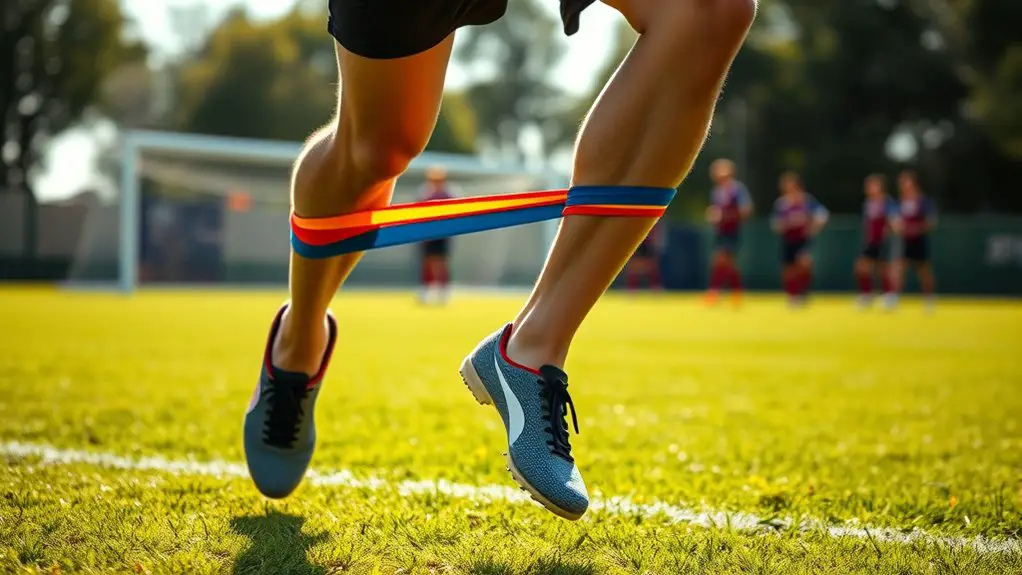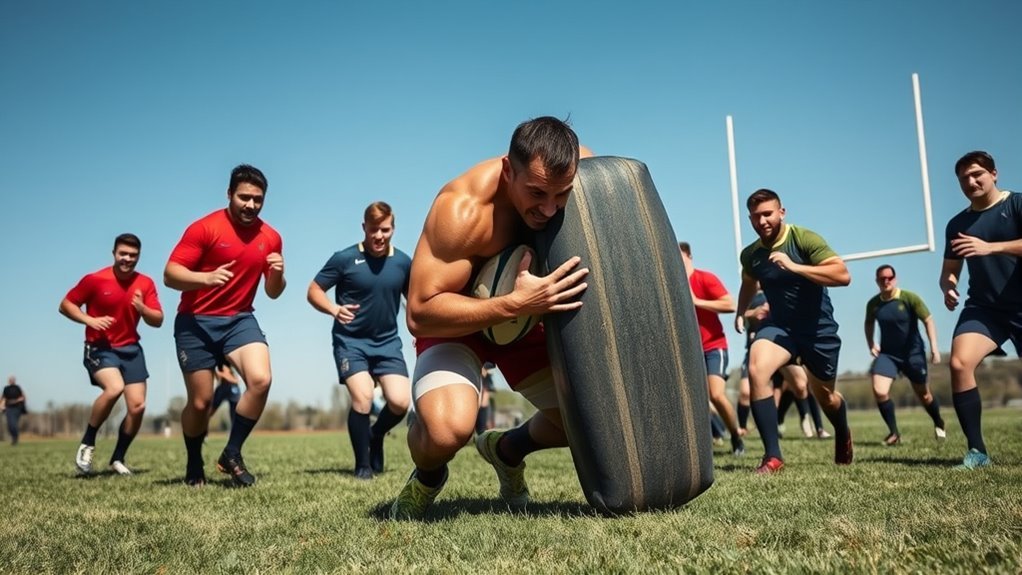Resistance band workouts are perfect for enhancing your soccer performance. They build leg strength with squats, improve agility with lateral band walks, and boost stability through lunges. To enhance your upper body, try seated rows, while plank variations will strengthen your core. Don't forget to cool down and stretch with bands to aid recovery. These exercises not only improve your skills but also reduce injury risk. Keep going, and you'll discover even more effective training tips for soccer success.
Benefits of Resistance Band Training for Soccer Players
When you incorporate resistance band training into your routine, you're not just adding variety; you're also enhancing your performance on the field. This form of training can greatly boost your muscle endurance, allowing you to maintain high energy levels throughout the game. By engaging different muscle groups, you'll develop strength that translates directly to your soccer skills, from sprinting to kicking.
Additionally, resistance bands are fantastic for injury prevention. They help stabilize muscles and joints, reducing the risk of strains or tears. As you strengthen these areas, you'll feel more confident and agile, giving you the freedom to move without the fear of getting hurt. Furthermore, strengthening surrounding muscles can significantly reduce the risk of Achilles tendon injuries, which are common in sports like soccer.
Warm-Up Exercises With Resistance Bands
Before hitting the field, warming up with resistance bands can really enhance your performance. You'll focus on dynamic stretching techniques that activate key muscles while improving your mobility and flexibility. This approach not only prepares your body for the game but also helps prevent injuries. Additionally, incorporating mobility training into your routine can further enhance your athletic performance and reduce the risk of strains and sprains.
Dynamic Stretching Techniques
Dynamic stretching techniques using resistance bands can greatly enhance your warm-up routine as a soccer player. These dynamic warm-ups not only increase your flexibility but also prepare your body for action. Incorporate resistance bands into your stretching routines for added resistance, which can help activate your muscles more effectively. Try exercises like banded leg swings, where you attach the band to your ankle and swing your leg forward and backward, or lateral band walks, which engage your hip muscles. These movements promote blood flow and improve your range of motion, making you feel freer on the field. By integrating these dynamic stretching techniques, you'll boost your performance and reduce the risk of injury, setting you up for success in every match.
Activation of Key Muscles
Incorporating resistance bands into your warm-up routine not only enhances flexibility but also activates key muscle groups necessary for soccer performance. By focusing on muscle activation, you can prepare your body for the explosive movements required on the field. Start with lateral band walks to engage your hip abductors, essential for maintaining stability during key movements like dribbling and passing. Next, try banded squats, which target your glutes and quads, helping you generate power for sprinting. Don't forget banded leg curls to activate your hamstrings, reducing the risk of injury. These exercises set the stage for a dynamic game, ensuring you're ready to move freely and effectively. Embrace these warm-up drills, and you'll feel the difference in your performance.
Mobility and Flexibility Focus
While you gear up for a soccer match, focusing on mobility and flexibility is essential for peak performance. Resistance bands can help you achieve dynamic mobility and improve your range of motion. Start with flexibility drills like banded leg swings; they'll loosen up your hips and legs. Try incorporating banded lunges to stretch your hip flexors while engaging your core. Another great option is the banded torso twist, which enhances your upper body mobility. These exercises not only prepare your body for the game but also help prevent injuries, allowing you to move freely on the field. Embrace these warm-up routines, and you'll feel more agile and ready to conquer the match!
Resistance Band Squats for Leg Strength
Resistance band squats are a fantastic way to build leg strength essential for soccer players, as they not only enhance power but also improve stability on the field. By experimenting with band squat variations, you can target different muscle groups effectively. The key is the resistance band placement; it can be positioned around your thighs, calves, or even over your shoulders for added intensity. Incorporating these exercises can lead to better performance and injury prevention during matches.
Here's a quick table to help you visualize different variations:
| Variation | Resistance Band Placement | Target Muscle Group |
|---|---|---|
| Basic Band Squat | Around thighs | Quads, Glutes |
| Overhead Band Squat | Over shoulders | Total leg muscles |
| Low Band Squat | Around calves | Hamstrings, Glutes |
Incorporate these variations into your routine, and you'll feel the difference in your leg strength and overall performance on the field!
Lateral Band Walks for Agility and Stability
Lateral band walks are a great way to enhance your agility and stability on the soccer field. This exercise focuses on lateral movement, which is essential for dodging opponents and changing direction quickly. To start, place a resistance band around your thighs, just above your knees. Stand with your feet shoulder-width apart and slightly bend your knees.
Now, step to the side with your right foot, followed by your left, maintaining tension in the band. Aim for a smooth, controlled motion as you perform 10-15 steps in one direction, then switch sides.
Incorporating lateral band walks into your footwork drills will help strengthen the muscles used in those quick side-to-side movements. You'll feel more stable and agile, allowing you to move freely on the field. Consistent practice will sharpen your skills, giving you the edge you need during matches. Additionally, focusing on lateral movement during agility exercises will improve your overall performance on the field.
Resistance Band Lunges for Lower Body Power
Resistance band lunges are a game-changer for enhancing your lower body power. By using resistance bands, you can improve your strength while focusing on proper lunge technique. Plus, there are plenty of variations to elevate your training as you progress. Additionally, these lunges promote core engagement, which is essential for stability during athletic movements.
Benefits of Resistance Bands
Incorporating resistance bands into your training regimen can greatly boost your lower body power, especially through exercises like lunges. These bands provide variable resistance, allowing you to challenge your muscles in a way that traditional weights can't. You'll enhance muscle endurance, enabling you to maintain peak performance throughout a match. Plus, resistance training with bands promotes better stabilization, which contributes to injury prevention—essential for any soccer player looking to stay agile and free on the field. The versatility of resistance bands means you can easily adjust the intensity to match your goals, giving you the freedom to tailor your workouts. Embrace this tool, and watch your lower body strength and confidence soar!
Proper Lunge Technique
Mastering proper lunge technique is essential for maximizing the benefits of resistance band lunges. Start by standing tall, feet hip-width apart, and secure the band under your front foot. Step back with one leg, lowering your body until both knees reach about 90 degrees. Your front knee shouldn't go past your toes. Engage your core and push through your front heel to return to standing. Experiment with lunge variations, like reverse lunges or lateral lunges, to target different muscle groups and enhance lower body power. Focusing on form not only prevents injury but also amplifies lunge benefits, including improved strength, balance, and flexibility. Embrace the freedom of movement and watch your soccer performance soar!
Variations for Advanced Training
While you're already familiar with the basics of resistance band lunges, incorporating advanced variations can greatly enhance your lower body power. Try using advanced techniques like the lateral lunge with a resistance band anchored to one side. This complex movement targets your glutes and inner thighs, giving you explosive strength for those quick soccer maneuvers. Another option is the reverse lunge with an overhead press; as you step back, press the band overhead to engage your core and improve stability. Finally, mix in single-leg lunges to challenge balance and coordination. These variations not only build strength but also promote freedom of movement, allowing you to unleash your full potential on the field.
Seated Rows to Enhance Upper Body Strength
To boost your upper body strength, seated rows are an excellent addition to your training routine. This exercise targets your back, shoulders, and arms, helping you build the strength needed for those intense soccer matches. Using resistance bands, you can easily incorporate various resistance band techniques to customize the intensity to suit your fitness level.
To perform seated rows, sit on the floor with your legs extended. Loop the band around your feet and hold the ends. Pull the band towards your torso, squeezing your shoulder blades together as you row. Focus on controlled movements to maximize your upper body exercises' effectiveness. Aim for 3 sets of 10-15 reps, adjusting the resistance as needed.
Incorporating seated rows into your workouts not only enhances your upper body strength but also promotes better posture and stability, essential for your overall performance on the soccer field. Additionally, a strong core helps prevent injuries and supports proper body mechanics during your gameplay. Enjoy the freedom of movement this exercise provides!
Resistance Band Plank Variations for Core Stability
Building upper body strength is important, but don't forget about your core stability, which plays a vital role in your overall performance on the soccer field. Resistance band plank variations can enhance core engagement, giving you the stability you need during matches. Here are some effective plank modifications to try:
Enhance your soccer performance by incorporating resistance band plank variations for improved core stability and strength.
- Band-Resisted Plank: Loop a band around your back and hold the ends in each hand while you plank.
- Side Plank with Band Lift: In a side plank position, lift the band overhead for added resistance.
- Plank Jacks with Band: While in a plank, jump your feet in and out while holding the band for extra tension.
- Plank to Row: Alternate rowing the band while maintaining your plank position to engage your core.
- Kneeling Plank with Band: Use the band to create resistance as you hold a kneeling plank.
These variations will keep your core engaged and ready for every play! Additionally, incorporating mobility training into your routine can further enhance your stability and performance on the field.
Cool Down and Stretching With Resistance Bands
After an intense soccer workout, incorporating resistance bands into your cool down and stretching routine can enhance flexibility and aid recovery. Using band tension, you can target specific muscle groups, making your stretches more effective. Start with a gentle hamstring stretch; loop the band around your foot, and slowly extend your leg while keeping your back straight. This allows you to control the tension and deepen your stretch without risking injury.
For your quads, anchor the band to a sturdy surface, and pull your foot towards your glutes. This stretching technique not only improves flexibility but also helps release tightness from your workout. Don't forget to stretch your shoulders and back using the band, as these areas often hold tension. Additionally, proper nutrition strategies play a significant role in recovery, so ensure you're fueling your body well after your sessions. Remember, a proper cool down keeps you feeling free and ready for your next game, so embrace the benefits of resistance bands in your stretching routine!
Incorporating Resistance Bands Into Your Training Routine
While resistance bands may seem simple, they can greatly enhance your soccer training routine by adding resistance to your workouts and improving strength, stability, and endurance. To incorporate resistance bands effectively, consider the following tips:
- Choose the right resistance band types: Light bands for warm-ups and heavier bands for strength training.
- Start with basic exercises: Include squats, lunges, and lateral band walks to build a solid foundation.
- Focus on training progression: Gradually increase resistance or complexity as you grow stronger.
- Combine with soccer-specific drills: Use bands while practicing dribbling or shooting for added resistance.
- Stay consistent: Aim for 2-3 resistance band sessions a week to see real results. Additionally, incorporating functional strength training can optimize your overall athletic performance and injury prevention.
Frequently Asked Questions
How Often Should Soccer Players Use Resistance Bands in Training?
Think of your training like a dance; every step counts. For soccer players, using resistance bands can be a game-changer. Aim to incorporate them two to three times a week, allowing for sufficient recovery periods in between. This frequency helps build strength while keeping your body fresh, ready to release your full potential on the field. Just remember, balance is key; too much can weigh you down, while too little might leave you wanting more.
Can Resistance Bands Replace Traditional Weightlifting for Soccer Players?
Resistance bands can't completely replace traditional weightlifting for soccer players, but they offer unique benefits. They improve flexibility, stability, and muscle endurance, which are essential for your performance. However, their limitations include lower resistance levels compared to weights, which might hinder maximum strength gains. If you want freedom in your training, incorporating both methods can optimize your results. So, embrace resistance bands, but don't forget the value of lifting weights for balanced strength development.
What Resistance Band Levels Are Best for Soccer Players?
Imagine your legs soaring like a hawk, powered by the right resistance bands. For soccer, you'll want to mix light resistance and heavy resistance bands. Light bands are fantastic for warm-ups and agility, letting you move freely while building endurance. On the flip side, heavy bands add strength and power, vital for those explosive sprints. By balancing both, you'll access your potential and find that sweet freedom on the field.
Are There Any Risks of Using Resistance Bands Incorrectly?
Yes, there are risks of using resistance bands incorrectly. If you're not mindful of band safety, you might face injuries like strains or sprains. It's crucial to check for wear and tear on the bands and make certain you're using the right technique. Focusing on injury prevention can help you enjoy your workouts without worry. Always start with lighter resistance and gradually increase it as you become more comfortable, keeping your freedom of movement intact.
How Can Beginners Start Using Resistance Bands Effectively?
"Slow and steady wins the race." To start using resistance bands effectively, it's essential to choose the right band selection based on your strength level. Begin with basic workout routines that focus on form and control. Gradually increase resistance as you build confidence. Remember, it's about finding that freedom in movement, so listen to your body and don't rush. Enjoy the process and watch your strength soar!




